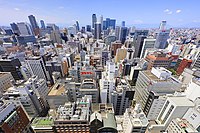
Photo from wikipedia
In modern Chinese history, the Nanjing Massacre generated brutally tremendous havoc. It began after the fall of Republic of China’s capital city Nanjing on December 13, 1937. The Nanjing Massacre… Click to show full abstract
In modern Chinese history, the Nanjing Massacre generated brutally tremendous havoc. It began after the fall of Republic of China’s capital city Nanjing on December 13, 1937. The Nanjing Massacre generally refers to more than 40 days of mass murders committed by the invading Japanese troops on Chinese prisoners of war and civilians. Through December 1937 to the restoration of order in February 1938, the Japanese army committed numerous horrendous acts of killing, looting, and raping inside Nanjing City. According to Chinese historian Daqing Yang, the Tokyo Trial (1946–1948) estimated that more than 200,000 people were killed, whereas the military trials held in Nanjing estimated a number of more than 300,000 deaths; both the Tokyo Trial and Nanjing Trial agreed that more than 20,000 Chinese women were raped during the massacre. One myth surrounding the Nanjing Massacre relates to its seemingly enigmatic disappearance from China’s public memorialization for several decades. Surprisingly, there were few reports or memorial activities honoring the Nanjing Massacre after the establishment of People’s Republic of China (PRC) until to the late 1970s. Jan Assmann asserts that the “alliance between power and forgetting” plays a formative role in the development of a “structural amnesia” that permits a society to define itself both prospectively and retrospectively. The communal organization of forgetting and oblivion could provide social cohesion, which partially explains the reason behind the disappearance of the Nanjing Massacre under regulations of Chinese political authority who determines what and who should be remembered in the public realm. According to Chinese historian Liu Yanjun, the Chinese government in fact mentioned the Nanjing Massacre in newspapers and public ceremonies for several times in the Cold War period before 1980s, which all played into the PRC’s changing political agenda in both domestic and diplomatic policies. During this time the Chinese Communist Party (CCP) was conforming to Chairman Mao Zedong’s political views and preoccupied with defining other nations as “Friends” and “Enemies.” Moreover, the CCP
Journal Title: Quarterly Review of Film and Video
Year Published: 2019
Link to full text (if available)
Share on Social Media: Sign Up to like & get
recommendations!